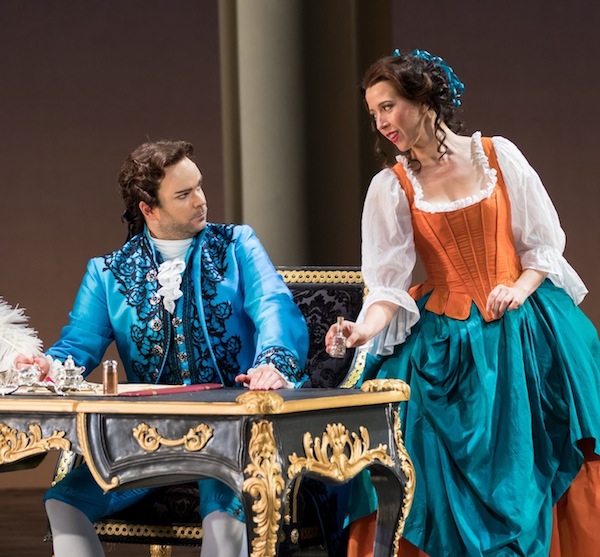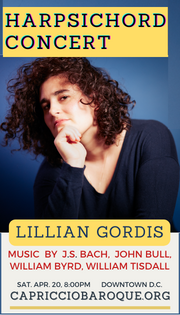WNO opens season with a visually attractive, vocally bland “Figaro”

Joshua Hopkins as the Count and Lisette Oropesa as Susanna in Mozart’s “Le nozze di Figaro” at Washington National Opera. Photo: Scott Suchman
This season at Washington National Opera, to borrow a sports metaphor, is a rebuilding year. After the impressive mounting of the company’s first Ring cycle last spring, it appears to be time to tighten the belts.
The season-opening production of Mozart’s Le nozze di Figaro, seen on Thursday night at the Kennedy Center Opera House, is something most people can like. The cast is decent, the production handsome. Much of it is quite easy on the eyes, but the ears are left disappointed.
The casting skewed young, with an emphasis more on physical appearance than vocal strength. Soprano Amanda Majeski made a tall, slender, elegant Countess dramatically credible as a young wife spurned by her husband. Unfortunately, her intonation was ragged, especially at the top, and the runs up to high C in the Act II trio “Susanna, or via, sortite” were rough and effortful.
Likewise the Count of Joshua Hopkins was a smarmy ham, manspreading with entitled excess when he sat down, but his baritone sounded too shallow and pale to back up the rodomontade.
Lisette Oropesa was charming as Susanna, a pretty figure for the cameras that will beam her image to Nationals Park Saturday night for the annual Opera in the Outfield Her somewhat transparent, nondescript sound either vanished behind the orchestra or pushed slightly flat in pitch.
Ryan McKinny, who seemed out of his depth in the Ring cycle last season, had the strongest vocal outing as Figaro, matched by the best comic timing. McKinney’s quick-witted Figaro bounded with energy, giving a mercurial, almost improvisatory quality in the recitatives especially, as well as an acidic edge as the character bristled indignantly at the Count’s presumption.
Keith Jameson was a fruity, spiteful Basilio in his company debut. Further down the cast list roles went to current and former members of the Domingo-Cafritz Young Artists program. Mezzo-soprano Aleksandra Romano had boyish energy as Cherubino, but her somewhat undisciplined vibrato made it hard to distinguish the center of the pitch. Ariana Wehr’s Barbarina was cute as a button, with a waif-like sound as she searched for the lost pin at the start of Act IV. Timothy J. Bruno and Rexford Tester had solid comic outings as Antonio and Don Curzio.
With something of a vacuum at the top of the cast, two veteran singers stole the show. Elizabeth Bishop, a WNO regular who has recently had fine Wagnerian turns as Brangäne and Fricka, was hilarious as Marcellina. Venomous and bitter, she also made the transition to Figaro’s loving mother credible, and her powerful voice stood out in the ensembles. Valeriano Lanchas, a former Domingo-Cafritz Young Artist himself, has had many a pleasing appearance in small comic roles over the years. The tradition continued here with his jowl-shaking Bartolo.
The company debut of conductor James Gaffigan produced about the same effect as his appearances with the National Symphony Orchestra in recent years. Tempos leaned forward at a breathless pace. Frantic gestures, often seemingly at odds with other frantic gestures, caused a few misalignments in the orchestra and on the stage, notably in the first choral scene. It was brisk, somewhat careless Mozart, with too many musical details flying by unnoticed.
Marcellina and Basilio’s arias were cut from Act IV, but otherwise the score is almost complete. Assistant conductor Michael Baitzer accompanied the recitatives capably at the harpsichord, rather than the fortepiano now generally recognized as more appropriate.
The company has adapted a production of the opera directed by Peter Kazaras at the Glimmerglass Festival. The neoclassical columns and marble white of the set pieces, designed by Benoit Dugardyn and serving all four acts, set the action clearly in the 18th century. The costumes by Myung Hee Cho are of the same period, but with a Technicolor twist, neon-bright colors that stood out in strong contrast to the basic white of the set pieces and the chessboard-patterned, raked floor.
On the architectural frieze at the top of the set is engraved the motto “Perdono non merta chi agli altri non dà” (He does not merit pardon who does not give it to others). The line is da Ponte’s, taken from the libretto’s second act as a sort of adage, a bit heavy-handed but reminiscent of Mozart’s underscoring of such nuggets of moral wisdom in The Magic Flute.
What is missing from this production is a visual awareness of the vastly different social stations of the characters. Figaro and Susanna are born of once-noble families who have fallen from their rank and are forced to work as servants. This comes across well when Marcellina threatens to besmirch a garment Susanna has been holding, knowing she can do so with impunity and make Susanna’s life harder. The servants should be more like the valet and lady’s maid in the television show Downton Abbey, scheming but always behind a veneer of proper subservience.
Le nozze di Figaro runs through October 2 at the Kennedy Center Opera House. The October 1 performance features a different cast, made up entirely of Domingo-Cafritz Young Artists. http://www.kennedy-center.org/calendar/event/OQOSG







Posted Sep 23, 2016 at 8:09 pm by Laura Youens
I haven’t seen (and don’t plan to see) this production, but you have pointed to problems that have made me cut back on attendance at WNO. The main one is a seeming disregard for singers who sound wonderful. Surely, surely there are singers out there who might not be famous (yet), but whose voices are lovely and merit attention. WNO doesn’t seem to be able to find them. It makes me sad. Frankly, I miss the Domingo years!
Posted Sep 24, 2016 at 10:36 am by David Rohde
It’s always great to see Valeriano Lanchas on our stages. I was lucky enough to catch his debut at the Met last December in The Barber of Seville (stated that way because it was their abridged English-language version “for the holidays”), where he was terrific also as Bartolo. Yes, I would like to see LIsette Oropesa develop a bit more distinctiveness to her sound. She’ll have a solo recital next March in Vocal Arts DC and it will be meaningful to hear what she does with a variety of repertoire in one evening. She’s part of a trend of singers who also advocate sports and fitness as a help, not a hindrance (she’s a runner). Always hoping for that new opera star who can kind of jump the boundary into more popular, cultural consciousness as we’ve had in the past.